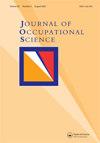Contested occupation in place: Experiences of inclusion and exclusion in seniors’ housing
IF 2.4
Q1 SOCIAL SCIENCES, INTERDISCIPLINARY
引用次数: 3
Abstract
ABSTRACT Congregate living among older adults aims to enhance important aspects of well-being, such as sense of community and social engagement. Such settings, however, involve a complexity of social and power relations, and inclusion and exclusion along lines of occupation and place can occur. In this paper we develop a concept of contested occupation in place and use this concept to explore experiences of inclusion and exclusion in a seniors-only apartment building. Data were drawn from a participatory action research (PAR) project aimed at building social connectedness among residents of this building. Throughout the project we collected data about the PAR processes and outcomes through observation and reflexive notetaking. We also conducted end-of-project semi-structured interviews with nine residents who were part of the PAR collective. Analysis focused on data pertaining to issues of occupation in place, including key collective occupations, points of tension, and links to communal spaces in the apartment building. The findings presented here centre on collective occupations in the building common room that were contested and illustrate how occupation in place can be a mechanism of exclusion. Residents attempted to assert power in a variety of ways, often related to pre-existing social tensions. These findings indicate the importance of attending to power dynamics over time and identifying potentially exclusionary practices within collective occupation in place. Further research can explore how dynamics at micro scales reflect larger societal dynamics of inclusion and exclusion, as well as explore additional settings in which older adults live and engage in collective occupations.有争议的职业:老年人住房中的包容和排斥经历
老年人聚会生活旨在增强幸福感的重要方面,如社区感和社会参与感。然而,这种环境涉及复杂的社会和权力关系,可能会出现职业和地点的包容和排斥。在本文中,我们提出了一个有争议的职业概念,并利用这个概念来探索老年公寓楼中的包容和排斥体验。数据来自参与性行动研究(标准杆数)项目,该项目旨在建立该建筑居民之间的社会联系。在整个项目中,我们通过观察和反射性笔记收集了有关标准杆数过程和结果的数据。我们还对标准杆数集体的九名居民进行了项目结束时的半结构化访谈。分析的重点是与现有职业问题有关的数据,包括关键的集体职业、紧张点以及与公寓楼公共空间的联系。这里介绍的调查结果集中在有争议的建筑公共休息室的集体职业上,并说明了现有职业如何成为一种排斥机制。居民们试图以各种方式维护权力,通常与先前存在的社会紧张局势有关。这些发现表明,关注随着时间的推移的权力动态,并确定现有集体占领中潜在的排斥性做法的重要性。进一步的研究可以探索微观层面的动态如何反映包容和排斥的更大社会动态,并探索老年人生活和从事集体职业的其他环境。
本文章由计算机程序翻译,如有差异,请以英文原文为准。
求助全文
约1分钟内获得全文
求助全文
来源期刊

Journal of Occupational Science
SOCIAL SCIENCES, INTERDISCIPLINARY-
CiteScore
4.30
自引率
41.70%
发文量
46
 求助内容:
求助内容: 应助结果提醒方式:
应助结果提醒方式:


